The Pragmatic Engineer 2025 Survey: What’s in your tech stack? Part 2
Tools software engineers use for project management, communication and collaboration, databases and backend infrastructure. Reader survey with analysis, based on 3,000+ responses
Hi – this is Gergely with the monthly, free issue of the Pragmatic Engineer Newsletter. In every issue, I cover challenges at Big Tech and startups through the lens of senior engineers and engineering leaders. If you’ve been forwarded this email, you can subscribe here.
Many subscribers expense this newsletter to their learning and development budget. If you have such a budget, here’s an email you could send to your manager.
During April and May, we asked readers of this newsletter about the tools in your tech stack and your opinions of them. We reported some results in Part 1 of this mini series, and today, we look into more metrics contained in the circa 3,000 responses. A big thanks to everyone who took the time to fill out the survey.
We cover:
Most-mentioned tools. JIRA, VS Code, and AWS lead the pack.
Project management. Linear is becoming a challenger to JIRA and is especially popular at smaller companies.
Communication and collaboration. Slack is the most frequently-used tool for chat, for video calling it’s MS Teams, Confluence for documents, Miro for whiteboarding, and Figma for design tasks.
Databases and data stores. PostgreSQL is the leading choice for databases, and there’s a very long tail of database solutions which professionals choose.
Backend infrastructure. Docker, Kubernetes, and Terraform are used everywhere, alongside many managed AWS services.
Load balancers. AWS API Gateway, nginx, Google Apigee, Envoy proxy and others.
Forks of popular open-source projects. OpenSearch seems to be eating into Elasticsearch’s market share, while Valkey and OpenTofu seem not to have persuaded many developers to drop Redis and Terraform.
In Part 1, we covered:
Demographics
AI tools
Most used, most-loved programming languages
Most hated (and loved) tools
IDEs and terminals
Version control and CI/CD
Cloud providers, IaaS, and PaaS
Observability, monitoring, and logging
Oncall tooling and incident management
Feature flags, analytics, and experimentation
Developer tools
Custom-built tools
Niche tools readers love
1. Most-mentioned tools
Below is a summary of the most-mentioned tools from around 3,000 survey respondents. Everyone mentioned several tools, and this chart lists those cited by at least 10% of respondents (300):
The biggest surprises for me:
JIRA is the most used tool. More software engineers work with JIRA than with VS Code or AWS – which is a surprise! It’s known that JIRA is widely used across tech companies, and the survey replies reveal just how much.
Figma mentioned more than Kubernetes or Cursor. Figma is a tool designers use for creating user interfaces which are easy to share with developers for collaboration. Figma recently went public, valued at $34B at the time of publication. It’s one of the most-used tools by software engineers, and our survey suggests why the company is so valuable.
Other observations on the most-used tools:
Microsoft is dominant across the tooling which developers use. VS Code (IDE), GitHub (version control), GitHub Copilot (AI coding) and GitHub Actions (CI/CD) are some of the most-used tools. Of the 15 most common tools, 4 are owned and operated by Microsoft.
Grafana, Datadog, and Sentry are popular with developers. Grafana (visualizing observability data), Datadog (observability), and Sentry (monitoring and performance analysis), are used by 15-25% of respondents – more than the likes of Notion and Google Workspace. Datadog is publicly traded and valued at $44B, Grafana is private and was last valued at $6B, while Sentry is valued at $3B. Given Grafana and Sentry seem to be equally popular with developers, it’s worth asking if they are actually undervalued compared to Datadog, or whether Datadog simply monetizes its software better.
2. Project management
Part 1 of the survey results found that JIRA is the “most disliked tool” among developers, based on the number of negative mentions subtracted by the number of positive mentions. This suggests that many engineers using JIRA don’t want to use it but have no choice, which makes sense because it’s often engineering leaders, product folks, or the CEO who select project management software. Smaller competitor Linear is the 4th most-loved tool. Let’s look closer at which tools software engineers use for project management:
Tools mentioned:
JIRA: the market leader.
Linear: an up-and-coming competitor to JIRA, tailored for teams building software products. We previously did a deepdive into Linear’s engineering culture.
Azure DevOps: an integrated solution that includes planning, project management, CI/CD, and testing.
GitHub Issues: GitHub’s built-in project management solution.
Asana: founded in 2008 by Facebook cofounder Dustin Moskovitz.
Trello: project management tool acquired by Atlassian (JIRA creator) for $423M in 2017.
ClickUp: project management and knowledge management app.
Shortcut: project management suite tailored for software teams, formerly known as Clubhouse.
Monday: generic project management platform.
Coda: collaborative workspace for teams to organize work.
Basecamp: project management for small businesses. Built by the bootstrapped 37signals.
GitLab Issues: GitLab’s built-in project management solution.
Hive: a generic project management solution for teams.
ZenHub: project management built on top of GitHub.
Azure DevOps is a surprisingly big hit for a product tied to Azure. Almost three times as many people use Azure DevOps as use GitHub Issues, despite GitHub having a much larger overall market share. Granted, Azure DevOps supports CI/CD as well as project management, but it’s still noteworthy how popular the tool is.
Looking closer, GitHub Issues seems to be popular at very small teams (50 or smaller) and Azure DevOps is a lot more used at larger companies:
Both Azure DevOps and GitHub are built by Microsoft, and the popularity of Azure DevOps makes me wonder if Microsoft may one day try to push Azure DevOps on GitHub users more, or integrate GitHub Issues to serve as an onboarding to Azure DevOps. Both might make business sense.
Linear is used far more by devs than its higher-valued publicly traded competitors. What I find curious is that Linear is valued at a comparatively modest $1.25B, while having far more developers using its project management solution than who use publicly traded competitors Asana (market cap $3.25B), and Monday.com ($9B.) This suggests Asana and Monday.com are more popular outside of software engineering.
If we take just JIRA and Linear, the pair account for close to 75% of tooling usage in this survey:
JIRA dominates at large companies, while Linear is surging at smaller ones this year. Let’s see how often JIRA and Linear are mentioned, by company size:
Linear is almost as popular at “tiny” companies (50 or fewer employees) as JIRA. At the same time, at workplaces with 1,000+ people, Linear is close to nonexistent. In the survey, developers at larger companies said they wish they could use Linear instead of JIRA. Here’s what two developers at larger companies think:
“Jira is just a hostile tool towards actually delivering stuff, antithetical to how great software should be IMO. I’d prefer to use Linear.”
“I dislike how JIRA tool is incredibly non-performant given what it does, and how it can get so bloated—and how fixing that takes a ton of tool-specific knowledge, admin privileges, and perpetual maintenance. I understand that task management software is hard to get right (I hate Asana even more), and if my company would allow it, I'd love to try Linear (or even just use Google Sheets more)”
One surprising finding is that even the smallest companies are still just about more likely to use JIRA than any other tool. It has managed to become synonymous with project management, and the default choice for many companies of all sizes.
3. Communication and collaboration
Here are the chat, video, document editing, and other communication-related tools which developers frequently use.
Chat
Slack dominates chat tools, with Microsoft Teams a distant second:
Other tools:
Discord: a popular chat platform originally built for gamers. Despite not being enterprise-ready, it’s still the third most-popular tool in this category. Discord is popular as a community support channel, with open source projects and in frontend communities. Our sense is that Discord is most used in these settings, and not for inter-company communication.
Google Chat: Google’s chat product. Even though it’s bundled free as part of Google Workspace, only around 10% of respondents who use Google Workspace said they use Google Chat
Mattermost: an alternative to Slack
Video calling
Only around a quarter of respondents named any tools for video calling (775 respondents). MS Teams is most popular:
Comparison in this category is a little tricky because MS Teams is a chat and video calling tool, while Google Meet and Zoom are solely for video calls. Other mentions include Cisco’s Webex, Tuple (a remote pair programming tool), and Slack Huddle (multi-person screen sharing, a feature inside Slack)
It’s surprising that Google Meet is more mentioned than Zoom because Zoom’s bread-and-butter is video calling, whereas Google Meet is a free Google Workspace add-on. Could we be seeing the search giant and Microsoft slowly but surely capturing Zoom’s market share – at least within tech companies?
Docs
What developers use for writing documents:
Most-mentioned tools:
Confluence: Atlassian’s wiki solution which integrates nicely with JIRA
Notion: a popular note taking and knowledge-sharing suite
Google Workspace: Google’s office suite
SharePoint: Microsoft’s wiki alternative
Microsoft 365: Microsoft’s office package
Confluence being so popular surprised me, not least because it’s the third most-disliked tool in our survey – although it’s also the most popular wiki and documentation tool among all companies. Seamless integration with JIRA – and being bundled as part of the Atlassian suite – seems more decisive in businesses adopting Confluence than developers’ complaints about it are.
The long tail of tools below is indeed lengthy, and each one was mentioned by under 1% of respondents (30 mentions)
Quip: document editing by Salesforce, tailored for sales teams
Obsidian: note-taking tool intended for single-user usage
Airtable: formerly an enterprise Google Sheets alternative, now transformed into a vibe coding app builder
Zoho: an office suite, as well as a customer relationship management (CRM) and email tool.
Slite: a knowledge base solution
MediaWiki: an open source wiki platform
MS Loop: Microsoft’s “Notion clone.” So little usage of this suggests that the popularity of Notion has less to do with how it looks (which Loop replicated), and more to do with how Notion works.
Dropbox Paper: the office suite by Dropbox
Evernote: a note-taking tool, now owned by Bending Spoons. In an episode of the Pragmatic Engineer Podcast, we go into detail on how Bending Spoons refactored Evernote’s backend
Logseq: a privacy-first knowledge base
Wiki.js: open source wiki software
Joplin: an open-source note-taking app
Whiteboarding and diagrams
For whiteboarding, Miro is the most-mentioned by survey respondents. Alternatives used by developers include:
FigJam: Figma’s online whiteboard
Mural: another Miro alternative
MS Whiteboard: Microsoft’s whiteboarding solution
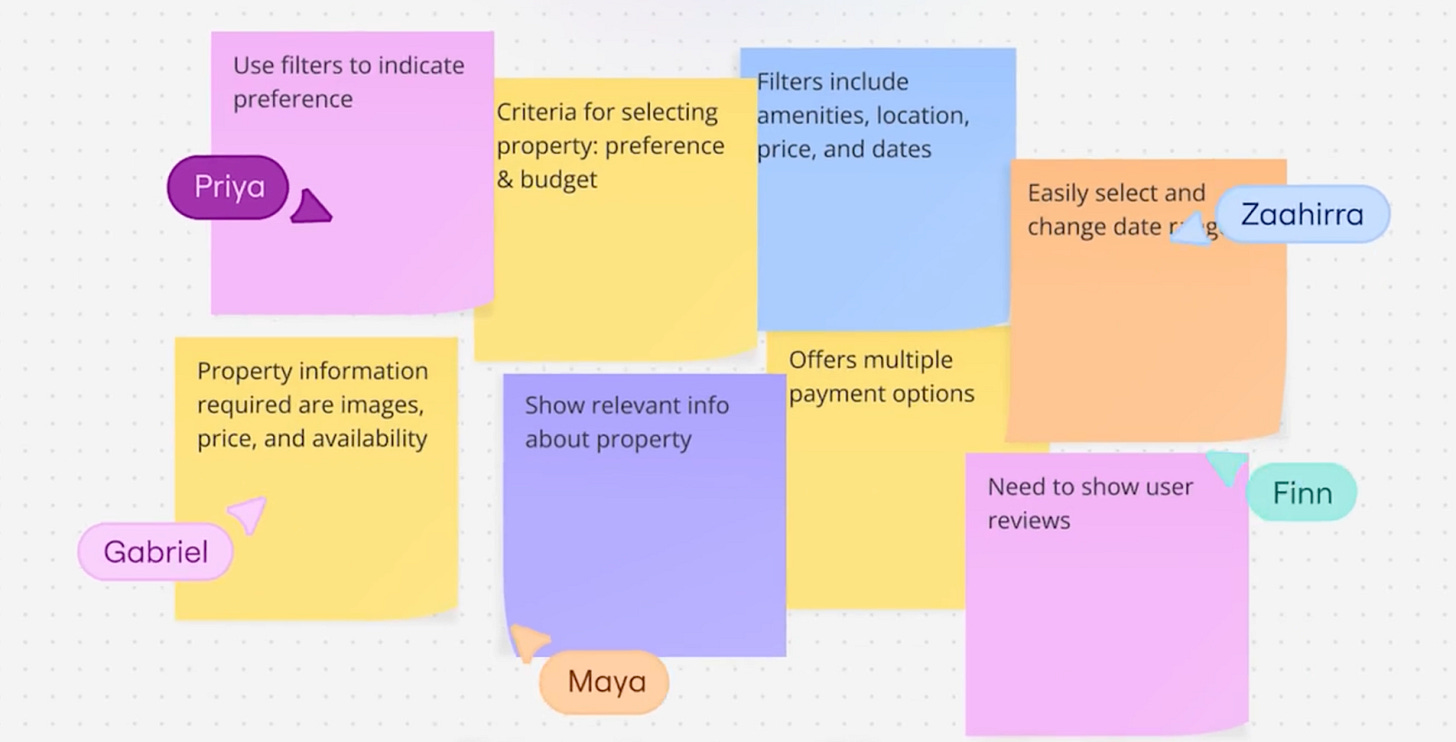
For creating diagrams, Lucidchart, Excalidraw, and Draw.io are equally popular, while there are honorary mentions for Mermaid (which renders Markdown into diagrams) and Microsoft’s Visio.
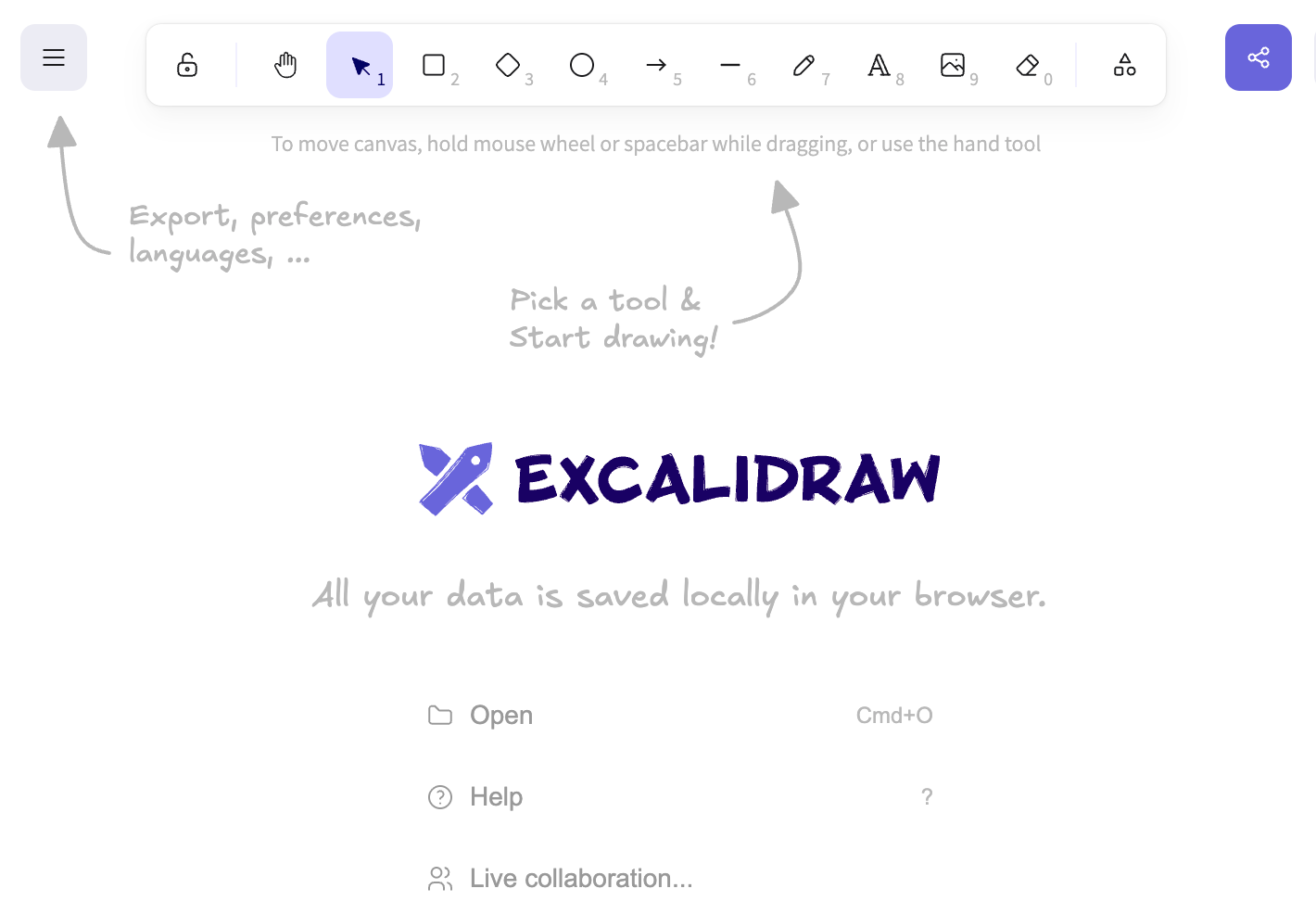
Working with design
The category of tools for collaborating with design is not even a contest:
In this category, 97% of all responses were for Figma. Meanwhile, Sketch (UX tool exclusive to MacOS) and Penpot (open source Figma alternative) also gained a few mentions.
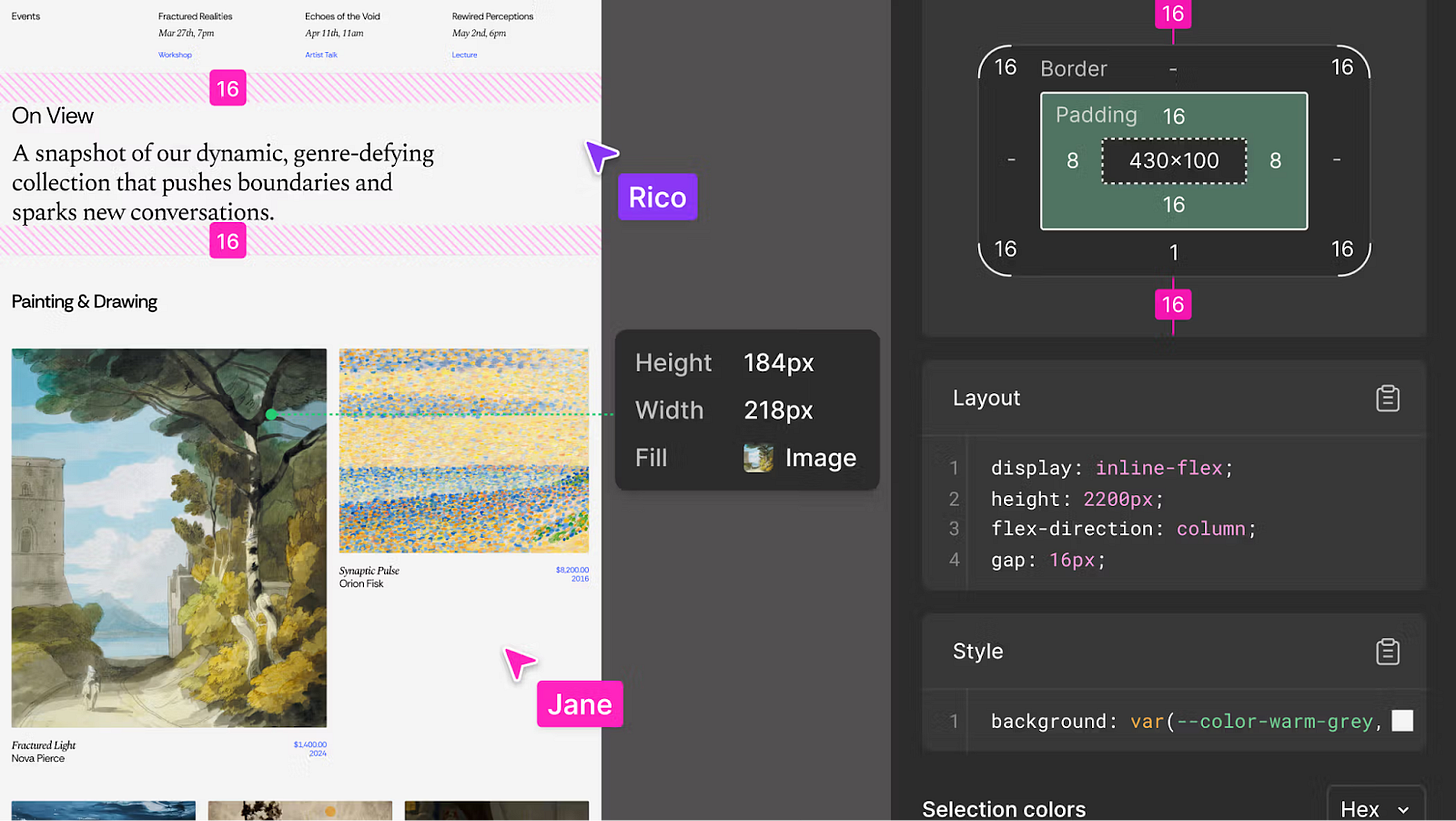
Figma has taken the design sector by storm since its public launch in 2017. Its biggest competitor today is Sketch, although “competition” seems to be pushing it a bit. Below is a visualization of just how fast Figma has won the market with its collaborative editor which works in browsers; something that no competitors could, or would, build:
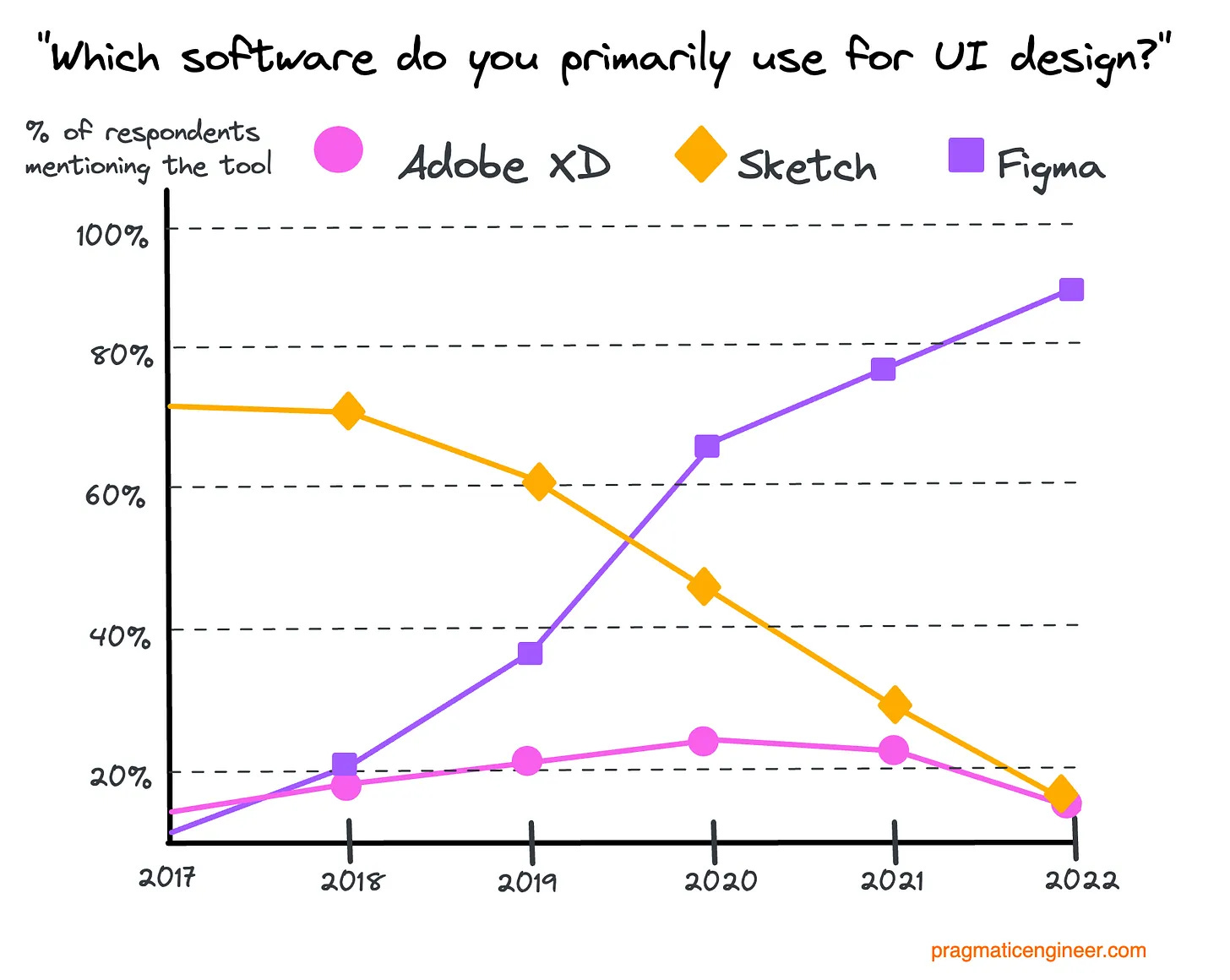
We did a deepdive into Figma’s engineering culture, and a podcast episode on How Figma Slides was built.
4. Databases and data stores
In Part 1 of the survey, we covered cloud providers, PaaS, and IaaS, with AWS being the most popular provider, followed by Azure and GCP. Let’s look further into the specific tools which respondents use; there is a wide spread of types of databases which engineers prefer:
A whopping 35 databases were mentioned by at least 6 people:
PostgreSQL: the most popular relational database. Open source, free to use, and robust.
MySQL: another popular SQL database, owned by Oracle.
Redis: an in-memory, key-value database with lots of use cases from caching to acting as a message broker
MongoDB: an open source NoSQL database
Amazon DynamoDB: Amazon’s distributed NoSQL database
Amazon RDS: Amazon’s service to run managed relational databases like PostgreSQL. Cursor used RDS for some time, as covered in our deepdive, Building Cursor.
Amazon S3: Amazon’s reliable cloud storage service
Firebase: a backend-as-a-service (BaaS) platform by Google
Microsoft SQL Server: Microsoft’s relational database
Snowflake: data platform for data warehousing and data lakes.
Amazon Aurora: a fully managed relational database compatible with PostgreSQL and MySQL
Oracle: a tried and tested enterprise SQL database
Databricks: data platform for data warehousing and data lakes.
Google BigQuery: Google’s NoSQL database
ClickHouse: a high-performance, open source, column-oriented database designed for online analytical processing (OLAP) of large datasets
SQLite: a self-contained, fast SQL library.
MongoDB Atlas: a managed service for MongoDB databases
MariaDB: an open source relational database, which started in 2009 as a fork of MySQL
Apache Cassandra: an open source, distributed, NoSQL database
Supabase: backend-as-a-service (BaaS) platform built on top of PostgreSQL
Azure CosmosDB: Microsoft’s managed NoSQL service
Neon: a managed Postgres platform
DuckDB: an open source, analytical database management system (OLAP DBMS)
CockroachDB: a distributed SQL database
TiDB: an open source, MySQL-compatible distributed database
Trino: distributed SQL query engine for big data
InfluxDB: a database for time-series data
Pinecone: a vector database
PlanetScale: a serverless relational database, built to efficiently scale up. Cursor recently moved some of its data storage to PlanetScale.
There is an overwhelming choice of databases. What’s great to see is that there’s no shortage of mature, production-ready databases to choose from. Just figure out your requirements and which specialized use cases you need to support, and there’s sure to be a tool purpose-built for your use case.
With so much on offer, you’ll likely not want to build your own database, although it can sometimes be hard to resist the temptation! For example, we covered how observability startup Honeycomb built its own database in this podcast episode with CTO, Charity Majors.
Despite 100+ alternatives, PostgreSQL remains the default database choice for most teams. One in three respondents use PostgreSQL – and no other database technology comes close in popularity. PostgreSQL is open source, with a large number of extensions that can add functionality – from support for full text search, to support for hypothetical indexes, you’ll probably find extensions that solve your problems. And you can also build your own.
Managed platforms for running Postgres are also popular: Amazon RDS, Supabase, and Neon are all examples.
It seems that vector databases haven’t taken off, even as LLM applications are doing so; at least, the survey results say that vector-only databases like Pinecone and Weaviate are little used. This is likely because relational databases like PostgreSQL added vector support which works well enough – and most LLM applications can just store embeddings as vectors in these relational databases, or by using extensions like the Pgvector extension for Postgres, or the Atlas Vector Search addon for MongoDB. We previously analyzed relational databases as a good fit for vector storage in The Pulse #99.
There’s no “right” choice for which database to use. To emphasize the sheer variety on offer, here are ones mentioned in the survey by 6 respondents or fewer (0.2% of the total) – but which are used successfully:
Aiven: an open source data platform
TimescaleDB: a time-series database for high performance
PrestoDB: distributed SQL query engine
IndexedDB: local web storage via a JavaScript API for managing NoSQL objects. Why use a remote database when you can use a local one?
Yugabyte: a distributed PostgreSQL database. Cursor originally used Yugabyte.
Weaviate: a vector database
Memgraph: a high-performance graph database
ArangoDB: an open source, distributed, multi-model database with flexible data modeling
Amazon Neptune: a managed graph database
Qdrant: an open source, high-performance vector database
OrientDB: multi-model database
Turbopuffer: a serverless vector database, which Cursor also uses
5. Backend infrastructure
The most-mentioned backend infra tools:
The tools:
Docker: the most popular container technology. Allows packaging applications into containers.
Kubernetes: the most popular container orchestration system.
Terraform: the leading infrastructure-as-a-code (IaaC) tool. Terraform is often used to provision to manage Kubernetes clusters.
Amazon ECS (Elastic Container Service): AWS’s service for running containers (such as Docker ones) in a secure, reliable and scalable way.
Amazon EKS (Elastic Kubernetes Service): a managed Kubernetes service by AWS
Amazon EC2 (Elastic Compute Cloud): run virtual servers on AWS
AWS CDK (Cloud Development Kit): the IaaC tool from AWS. Allows defining AWS cloud resources as code.
Helm: package manager for Kubernetes
Ansible: a popular IaaC tool. Define, provision, and manage infrastructure using code and YAML playbooks
AWS Fargate: serverless compute engine on AWS
Kong: an API gateway, serving as middleware between clients and APIs. Provides features like authentication, rate limiting, load balancing, logging, advanced routing, etc.
Istio: an open source service mesh. Manages and secures communication between microservices
GKE (Google Kubernetes Engine): a managed Kubernetes service by Google Cloud
Podman: an open source container engine for running pods on Linux. It offers simplicity and better security than Docker.
OpenShift: a container management platform built on top of Kubernetes, with additional features on top
AKS (Azure Kubernetes Service): a managed Kubernetes service by Azure
The popularity of AWS services is a bit surprising. We know AWS is the leading cloud provider, but it was still unexpected to see so many AWS services mentioned by hundreds of respondents each, such as ECS, EKS, EC2, and Fargate. A frequent complaint of AWS is that too many services are listed across the AWS panel for navigating them to be efficient, but I reckon devs building on top of AWS have their own set of preferred AWS services. Maybe AWS offering more than 240 services (and growing) reflects this demand?
Containerization is widespread, and Kubernetes is the most common approach to managing containers. When it comes to building scalable infrastructure, containers are the most common way to go. When it comes to containers, they are most commonly Docker ones. And for managing containers at scale, the most common tool of choice is Kubernetes. We do a deepdive on Kubernetes in the Pragmatic Engineer Podcast episode, How Kubernetes is built.
Streaming, messaging, queues
Sending messages between backend services is important to get right between microservices. Here are the most popular tools and services developers use for this task:
Tools mentioned:
Apache Kafka: an open source event-streaming platform, frequently used for message broker purposes or stream processing.
Amazon SQS (Simple Queue Service): a managed message queuing service by AWS
RabbitMQ: a popular messaging and streaming broker
Apache Spark: a distributed processing framework for large-scale data analytics
Apache Flink: stream event processing engine
Amazon Kinesis: a managed data streaming service from AWS
NATS: an open source, high-performance messaging system
6. Load balancers
The most-mentioned ones:
AWS API Gateway (90 mentions): a fully managed service from Amazon Web Services that allows developers to create, publish, maintain, monitor, and secure APIs at any scale.
nginx (72 mentions): A high-performance open source web server, reverse proxy, load balancer, and HTTP cache. It powers many of the world’s busiest websites and can handle hundreds of thousands of concurrent connections efficiently.
Google Apigee (26 mentions): Google Cloud’s native API management platform designed to build, manage, and secure APIs.
Envoy proxy (24 mentions): a modern, high-performance open source edge and service proxy originally built at Lyft, now a CNCF graduated project.
Traefik (22 mentions): A modern open source cloud-native reverse proxy and load balancer. It automatically discovers services and configures itself dynamically. Written in Go.
HAProxy (15 mentions): A fast and reliable open source software that provides high availability load balancing and proxying for TCP and HTTP-based applications. Used by many high-profile websites, including GitHub and Reddit.
7. How are forks of popular open source infra projects doing?
In recent years, several open source projects have changed their licenses to be more restrictive, including Elasticsearch, Redis, and Terraform. In each case, new forks were then created:
OpenSearch: created in response to Elasticsearch making its license restrictive in 2021. Elasticsearch went back to open source in 2024, and we analyzed this reversal in detail.
Valkey: Redis changed to a restrictive license in 2024, and the open source Valkey was created. A year later, Redis returned to being open source.
OpenTofu: created in response to Terraform moving to a more restrictive Business Source License (BUSL) in 2023. We analyzed this in more detail.
Here are the market shares of forks in this survey, based on numbers of mentions:
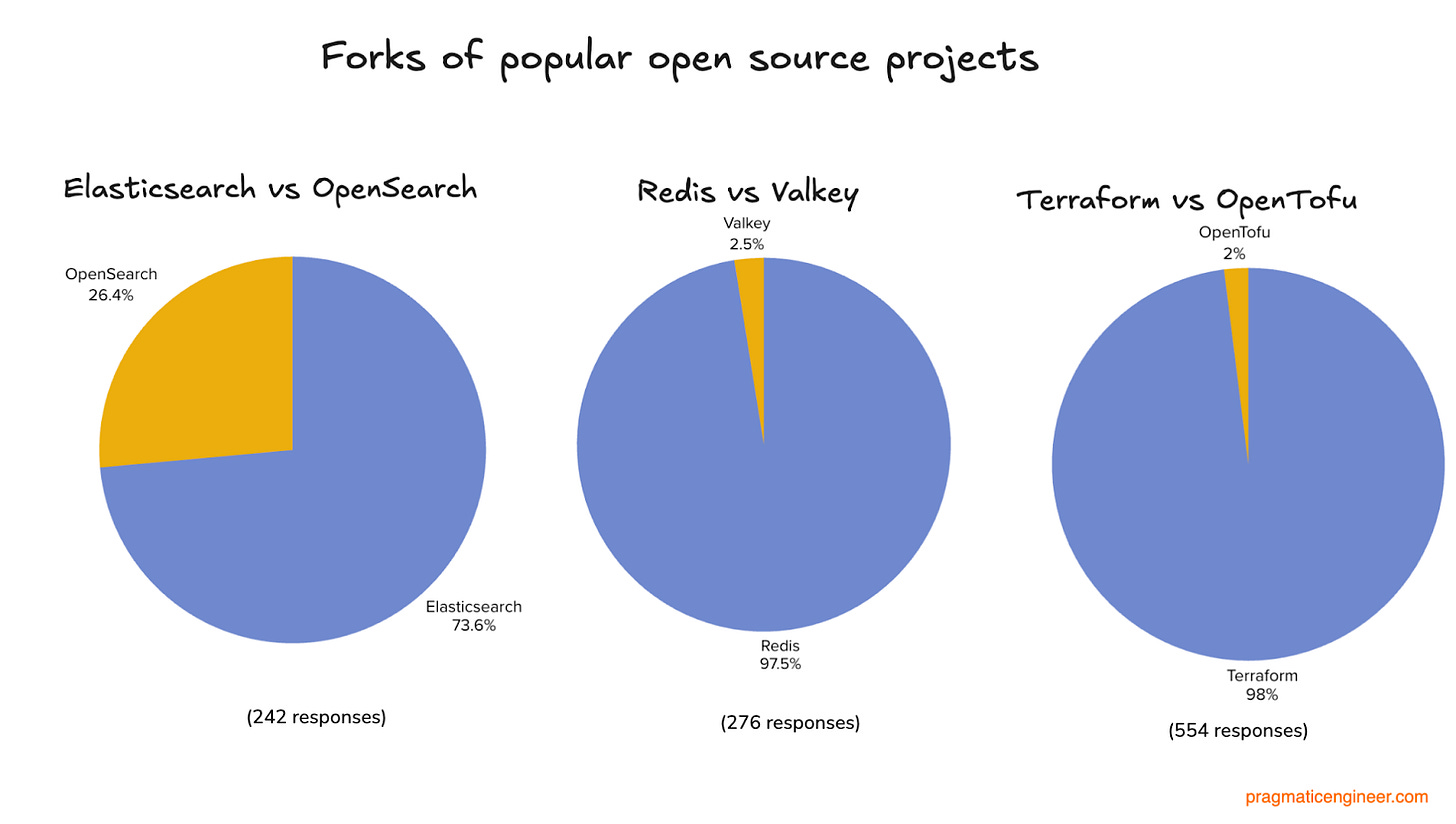
Open source forks seem to get little traction, except for Elasticsearch. The popularity of OpenSearch is likely to do with AWS: in 2021, Elasticsearch changed its license to no longer allow AWS to offer a managed Elasticsearch service without paying Elastic a licensing fee. In response, AWS started to offer a managed OpenSearch service and launched the Amazon OpenSearch Engine, which integrates nicely with AWS services like S3, Lambda and Kinesis.
In 2024, Elasticsearch went back to being open source, but AWS still does not offer a managed Elasticsearch service, given Amazon OpenSearch Engine works just as well. All things being equal for developers on AWS infrastructure, going with OpenSearch is not very different from using Elasticsearch – and a lot simpler in that case.
I wonder if the growing popularity of OpenSearch might be another reason why Elasticsearch changed back its license in 2024 to open source?
The survey also suggests Terraform has been almost unaffected by the open source OpenTofu. It continues to be licensed as Business Source License (BUSL), but in this case, the open source fork, OpenTofu, is not getting much traction.
To me, the contrast between OpenSearch’s wide adoption traction and OpenTofu’s lack of traction illustrates how important the identity of a company promoting an open source fork is. AWS committing to OpenSearch made a dent in Elasticsearch’s usage, whereas OpenTofu has no platform with a massive distribution behind it. The largest OpenTofu sponsors are Harness (software delivery platform), Spacelift (IaaC orchestration engine), and env0 (automating infrastructure at scale). All are promising infrastructure startups, but none has the size of customer base that AWS does.
Takeaways
Here are my top observations about this second part of The Pragmatic Engineer 2025 survey:
Project management is part of our job, as devs. Project management tools are as frequently mentioned as IDEs. That’s because creating and updating tickets is as much a part of an engineer’s job as writing code is. With AI tools spreading which promise to draft pull requests from well-written tickets, the expectation for us devs to document our tasks will likely only increase.
It’s hard to go wrong choosing PostgreSQL as a database. There are many specialized databases that offer better scalability than Postgres, yet it remains the leading choice across the industry. The pragmatic approach to databases might not be asking “which database should we use?” but rather: “what might stop us from using Postgres?”
It could be sensible to understand Kubernetes better, even if you don’t work with it. A quarter of respondents mention Kubernetes as part of their stack. If your workplace decides to be more hands-on with your infrastructure, the most obvious tool for this will be Kubernetes. We previously covered Kubernetes in the podcast episode How Kubernetes is built – it could be a good starting point for this container orchestrating technology.
Does forking have less impact on formerly open source projects than expected? The popularity of Redis and Terraform seems to not have changed since they stopped being open source, despite permissive forks being available. Elasticsearch is the counterpoint to this, with OpenSearch now used by around 25% of developers, compared to Elasticsearch. In that case, the caveat is Amazon.
I hope this article – along with Part 1 of this dive into the results of our latest survey of the state of dev tooling in 2025 – is interesting. In a future issue, we’ll wrap up the findings of this detailed look into the tech stacks of software engineers by focusing on frontend, mobile, and developer platform tools. Thank you to everyone who took part by filling in the survey!



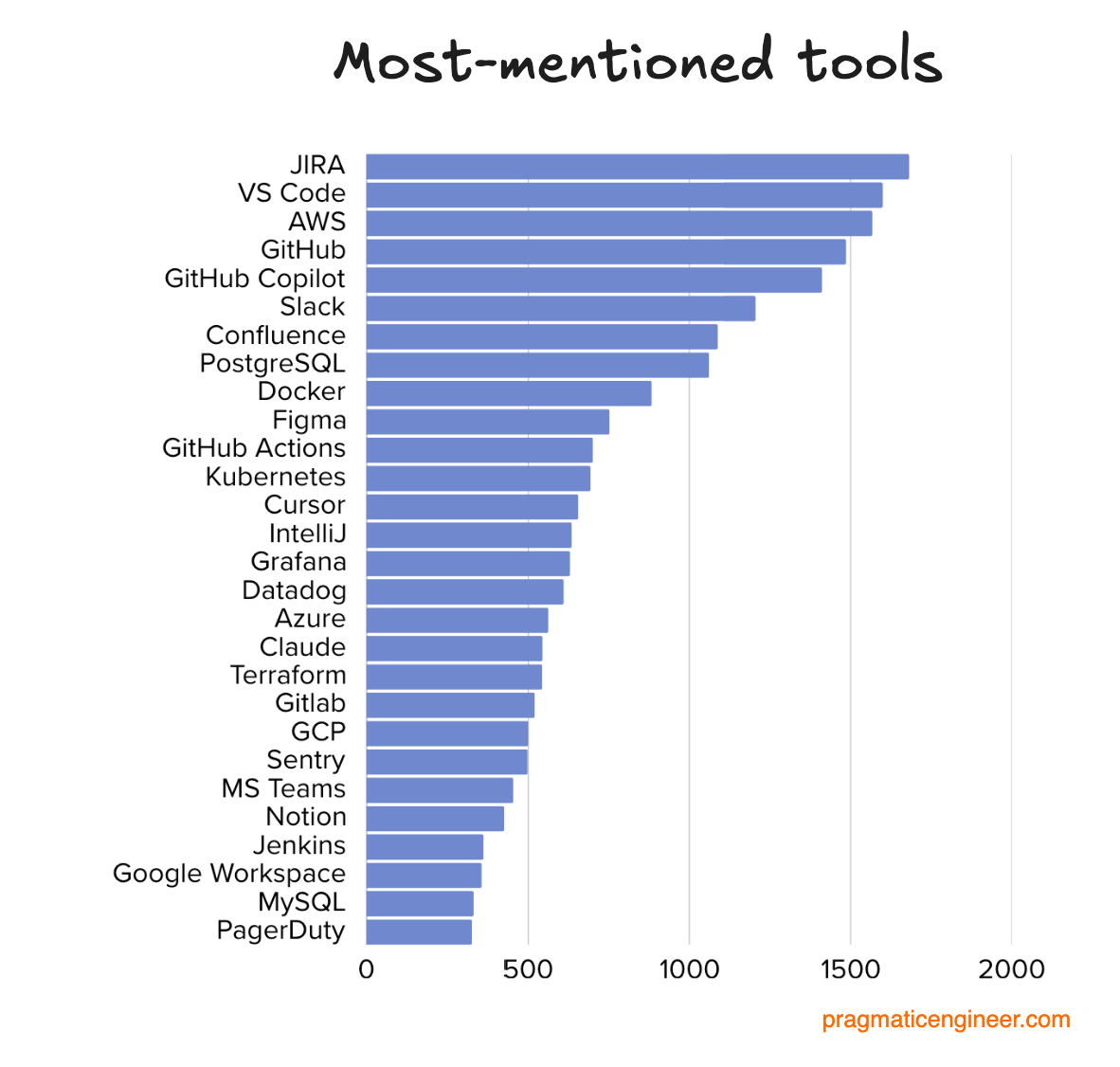
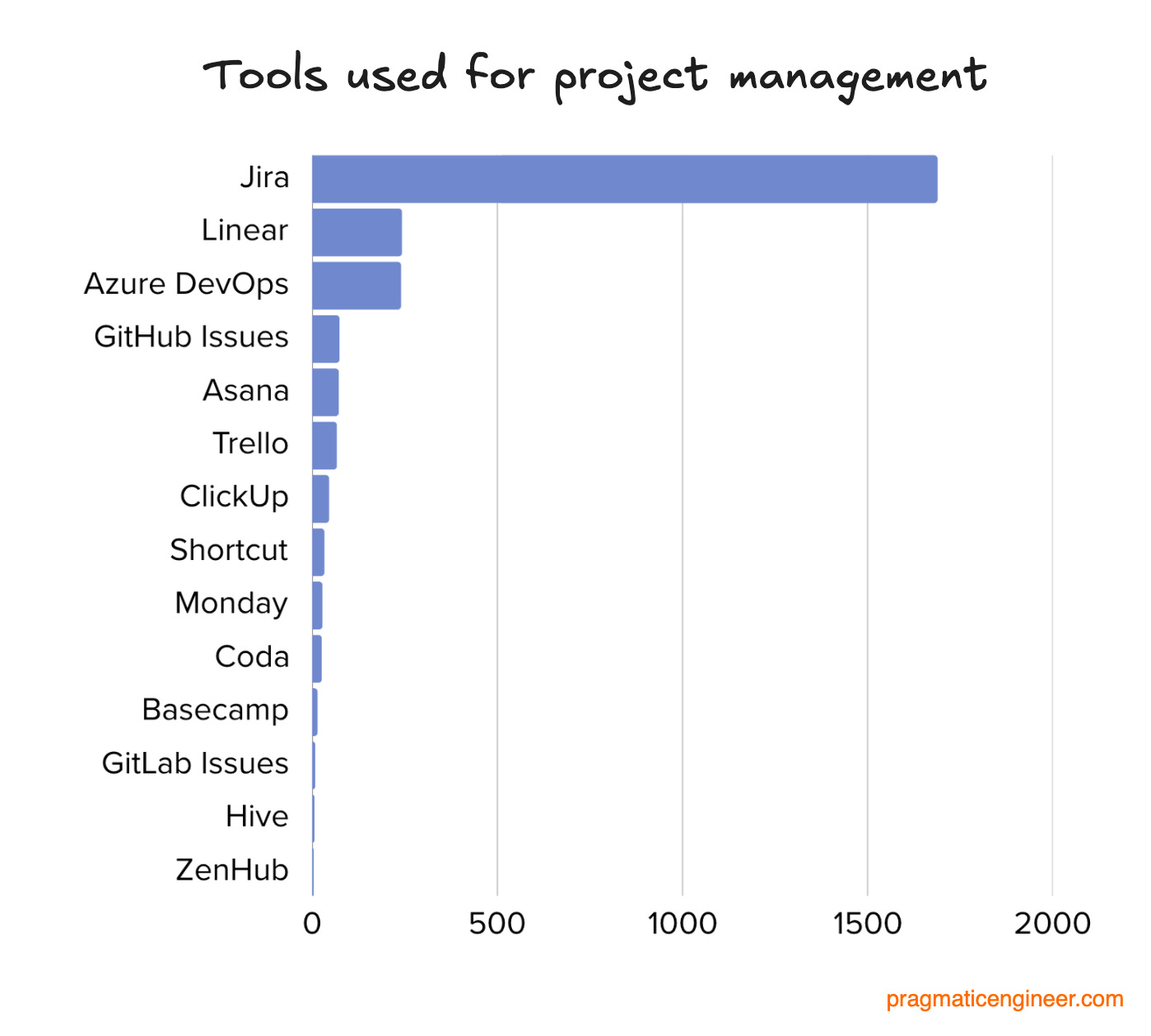
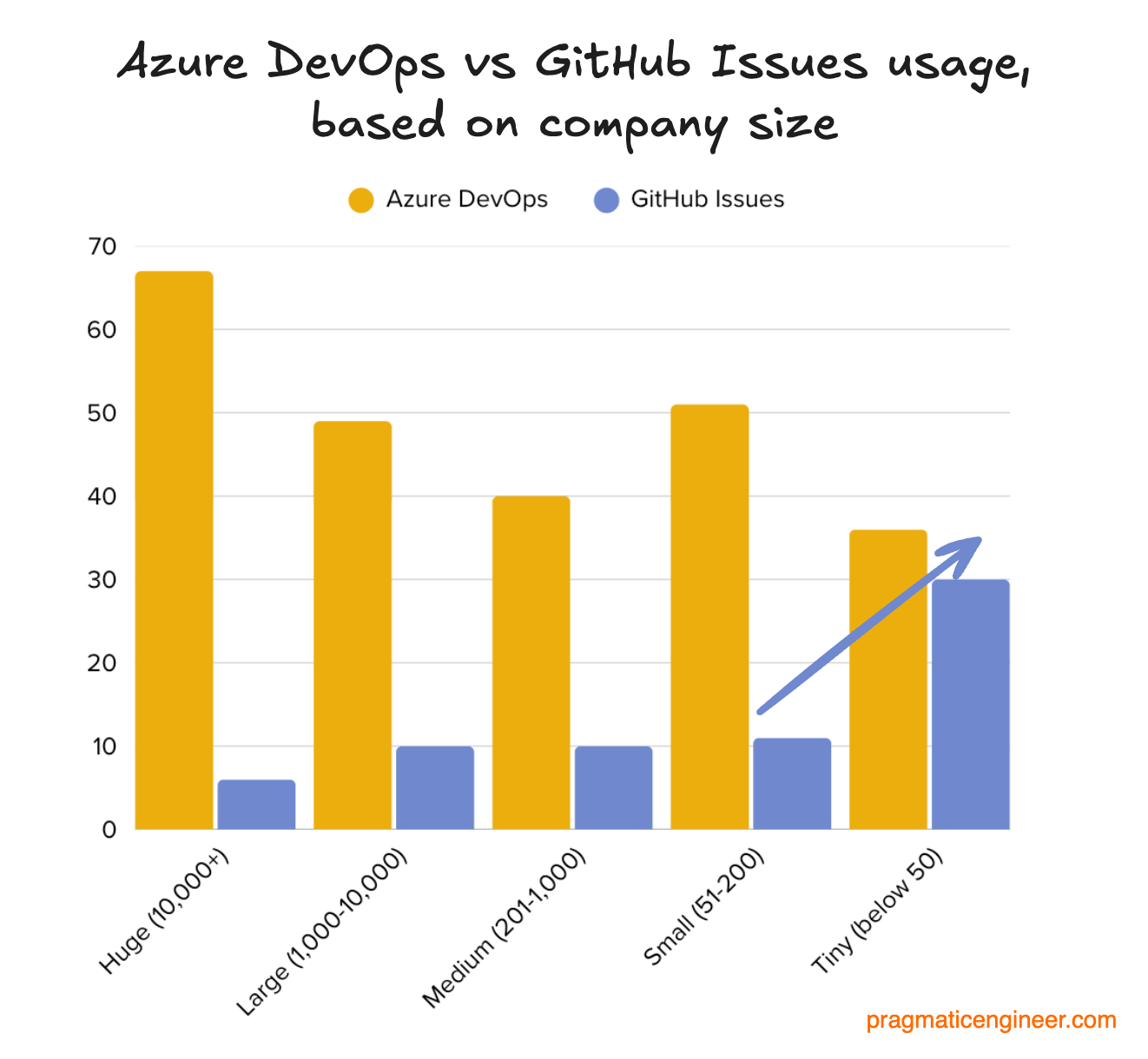
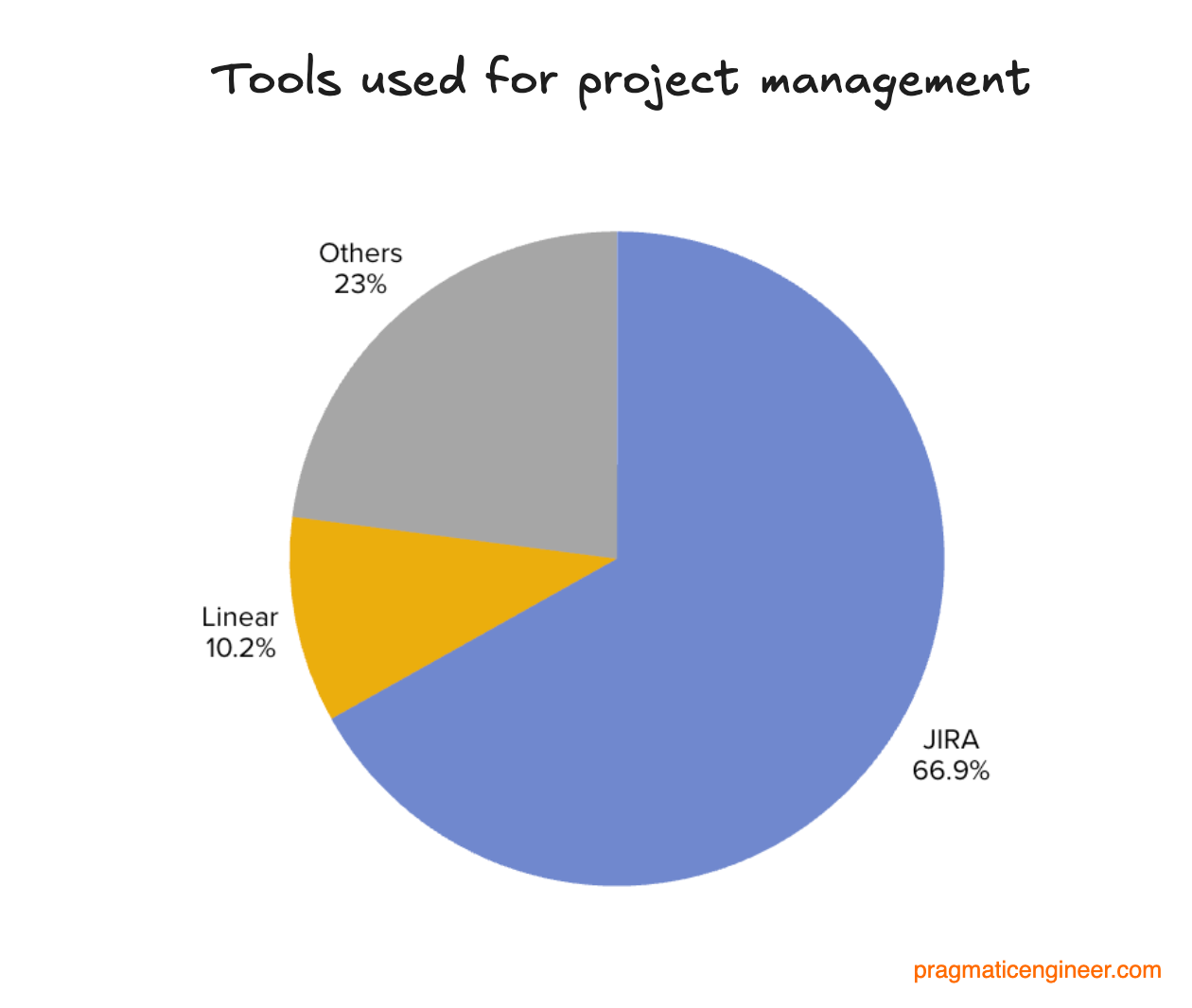
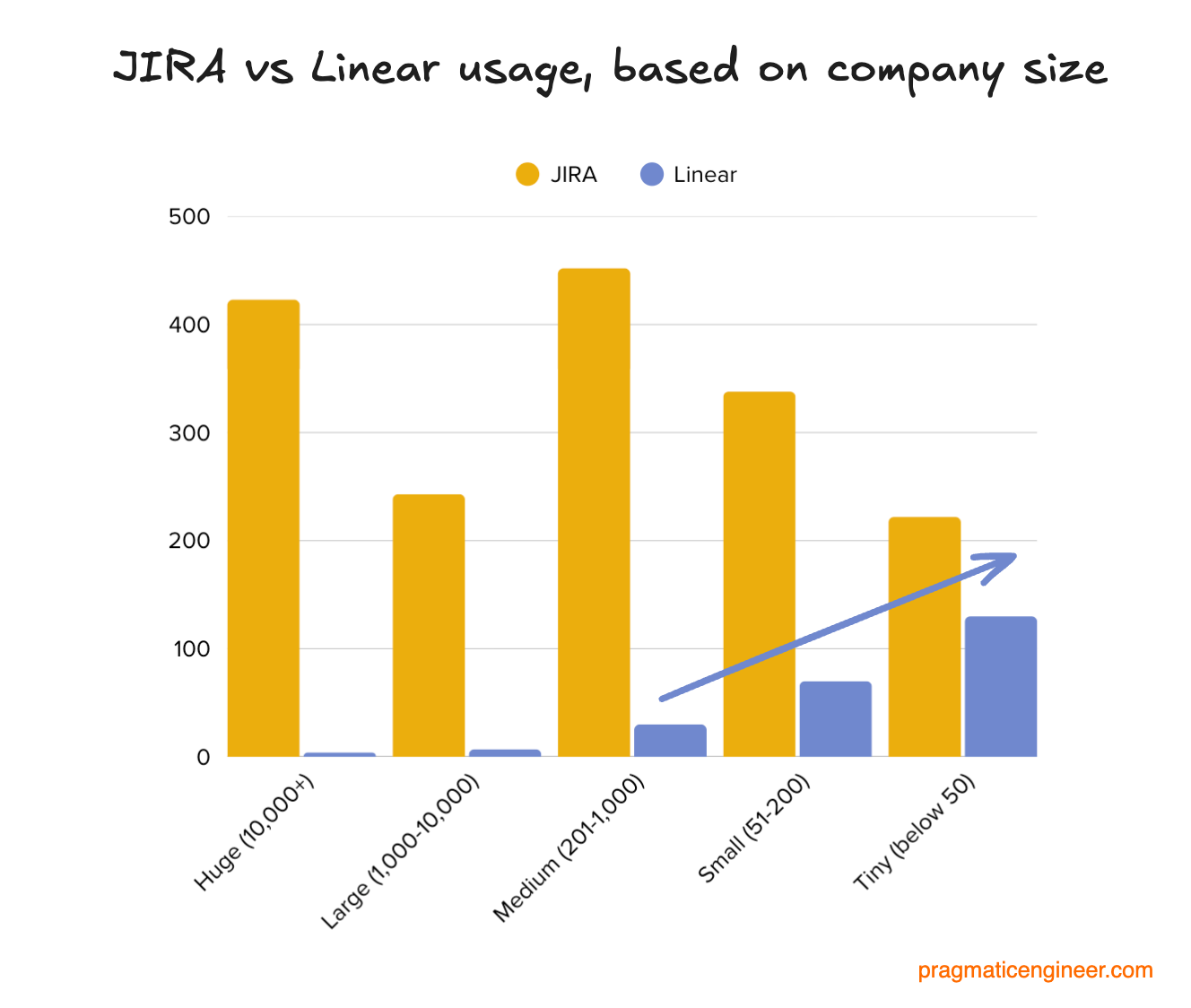
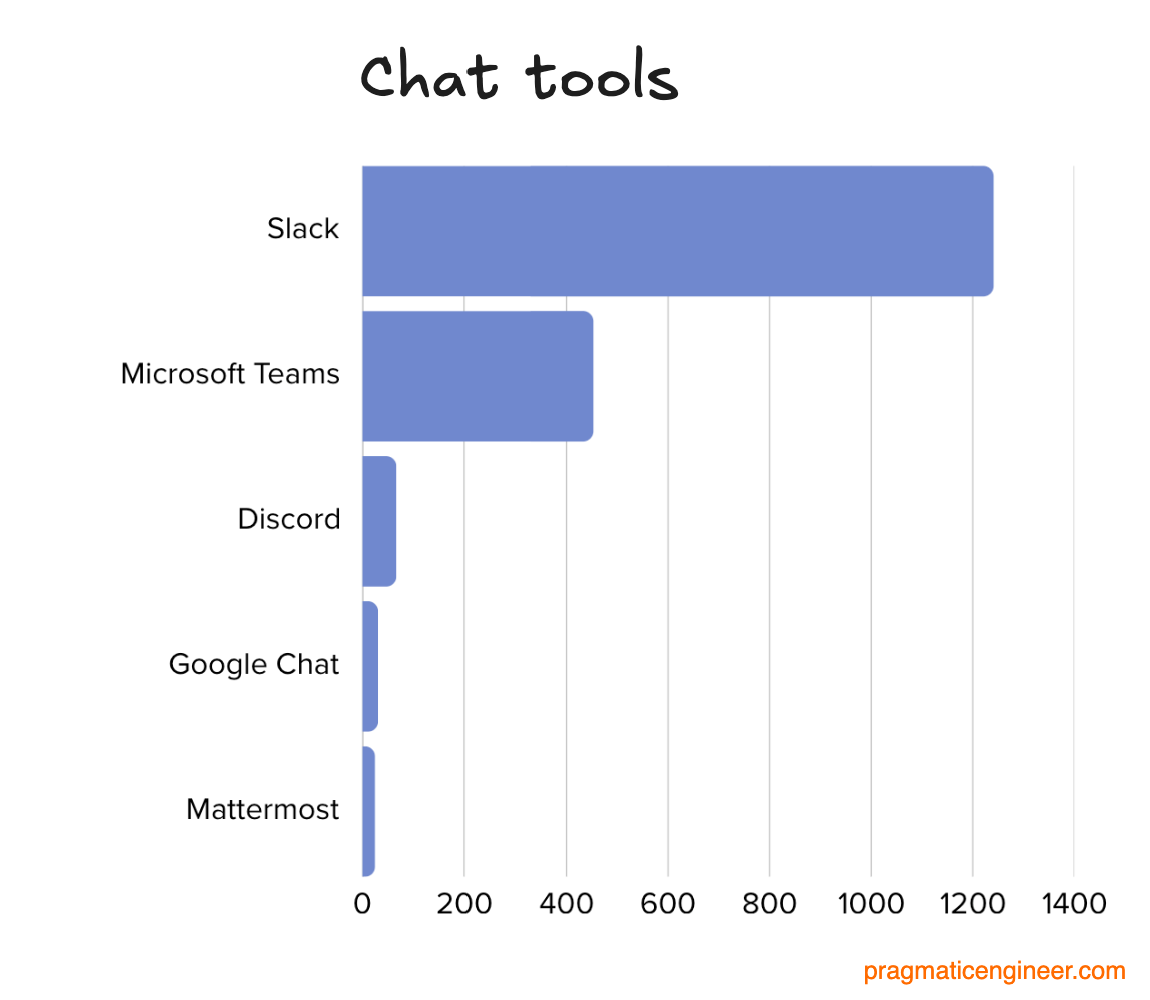
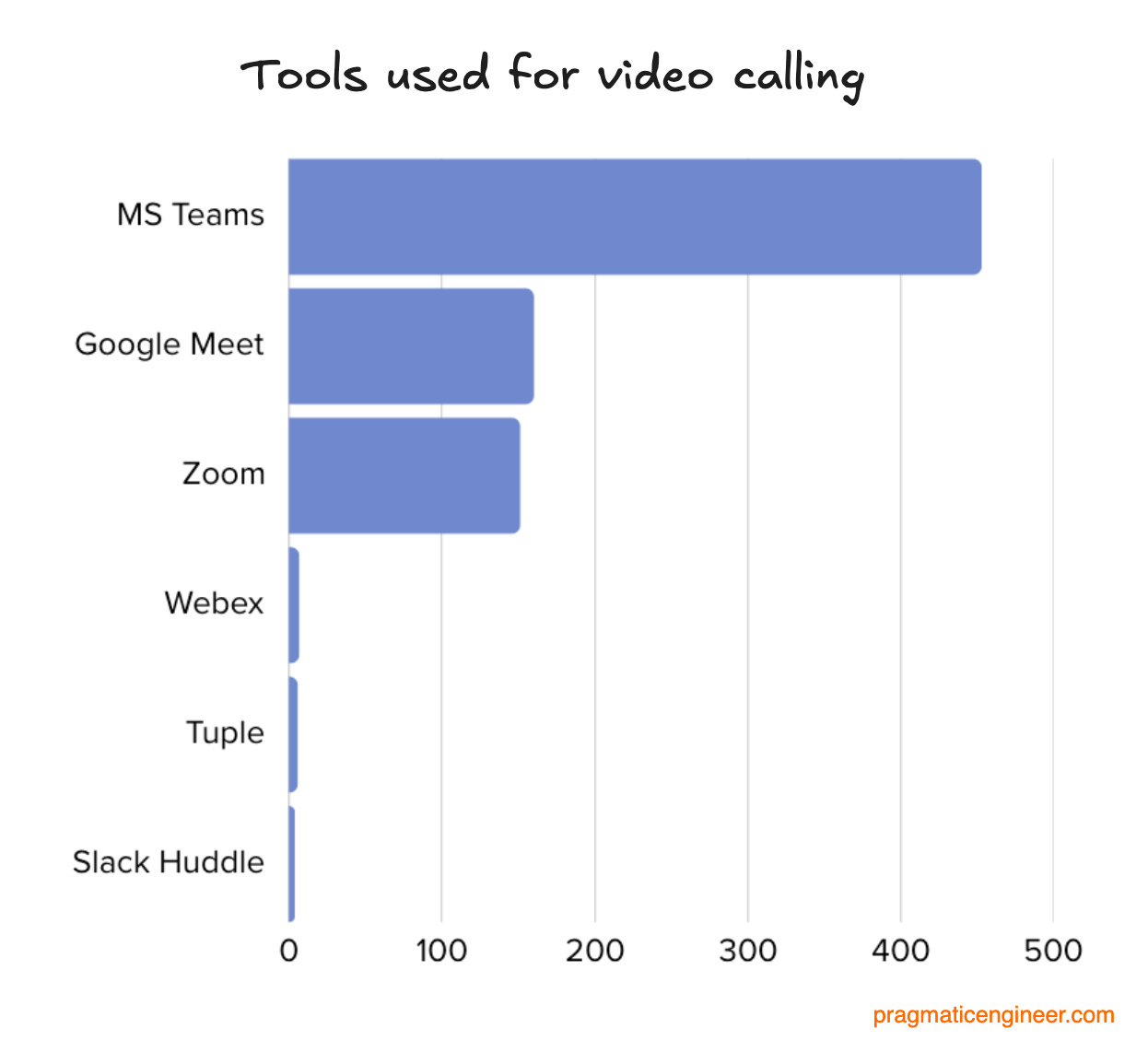
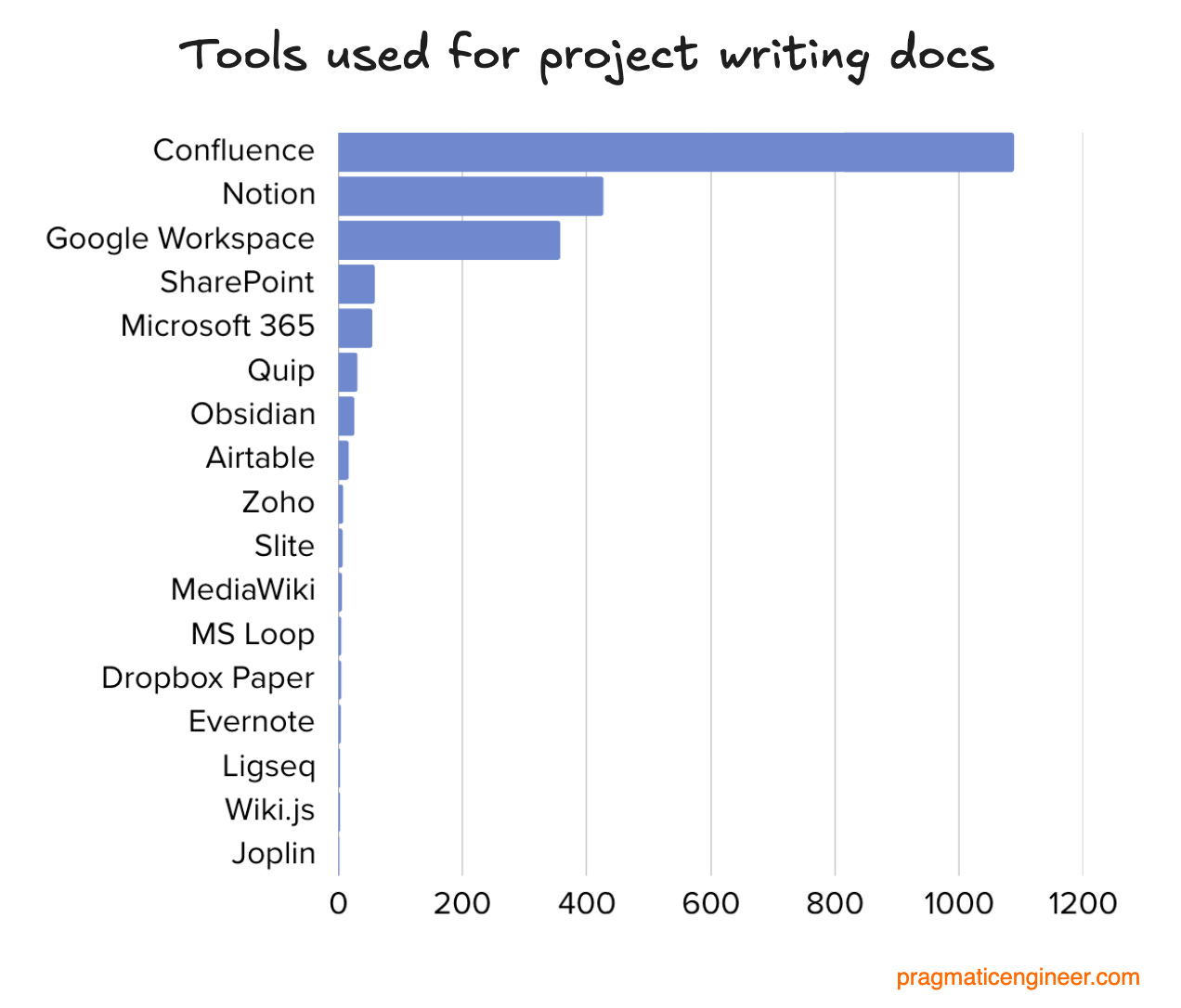
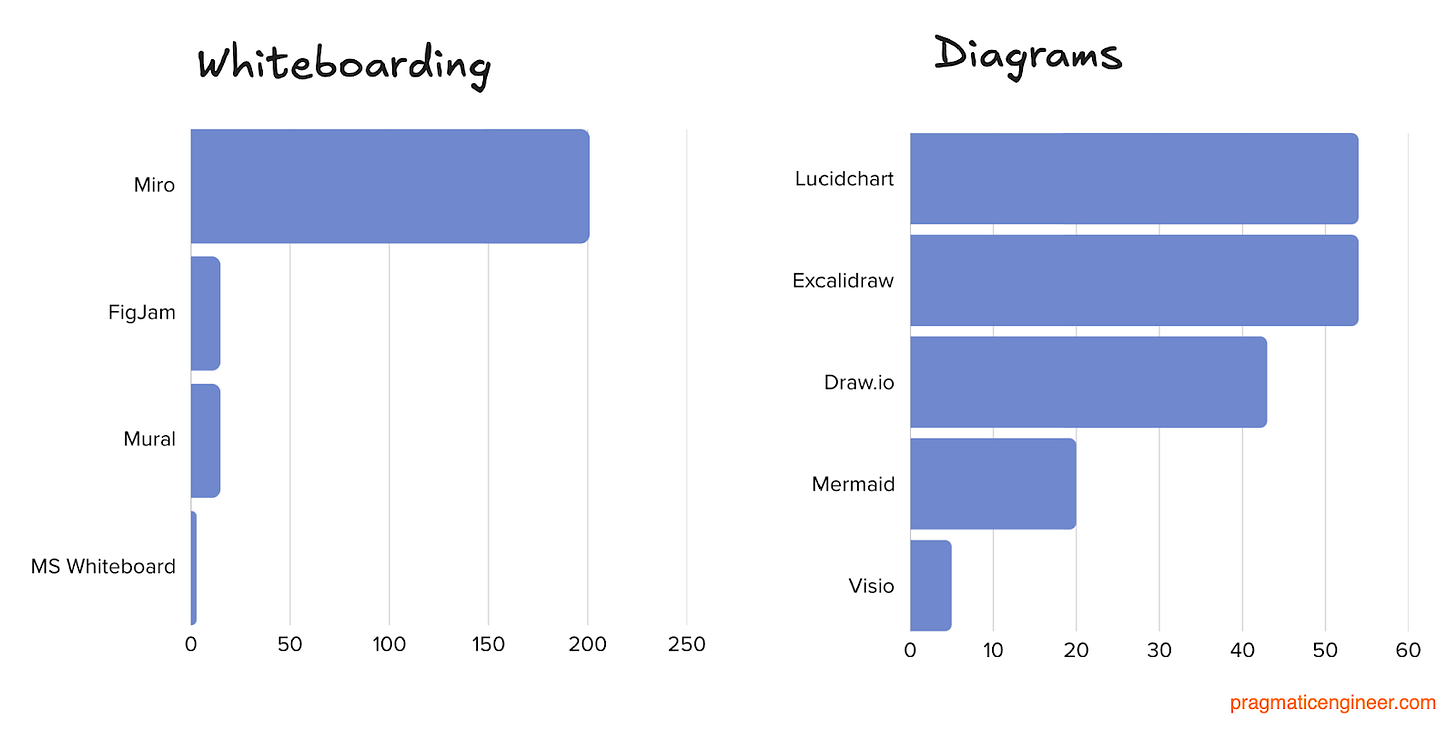
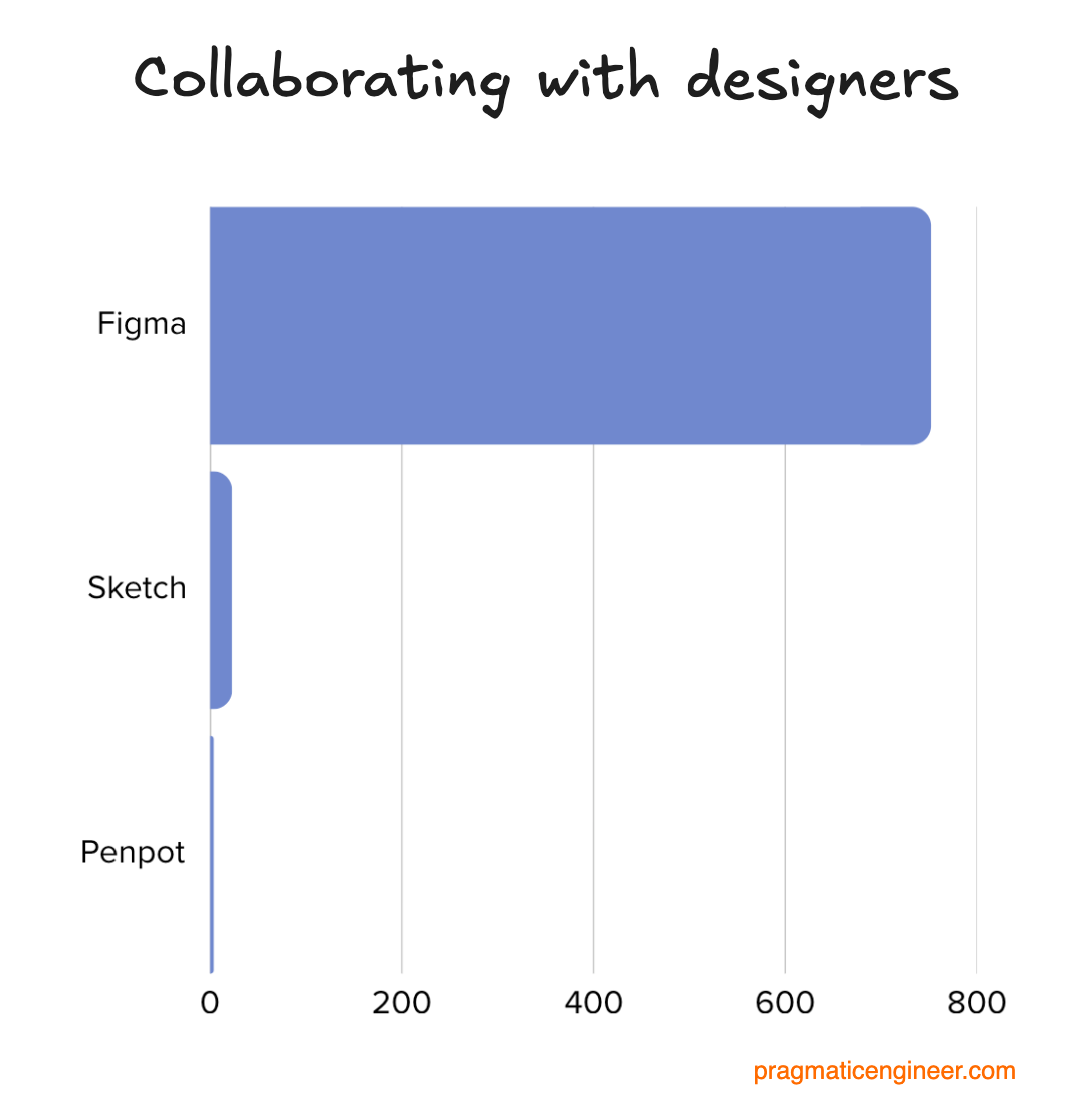
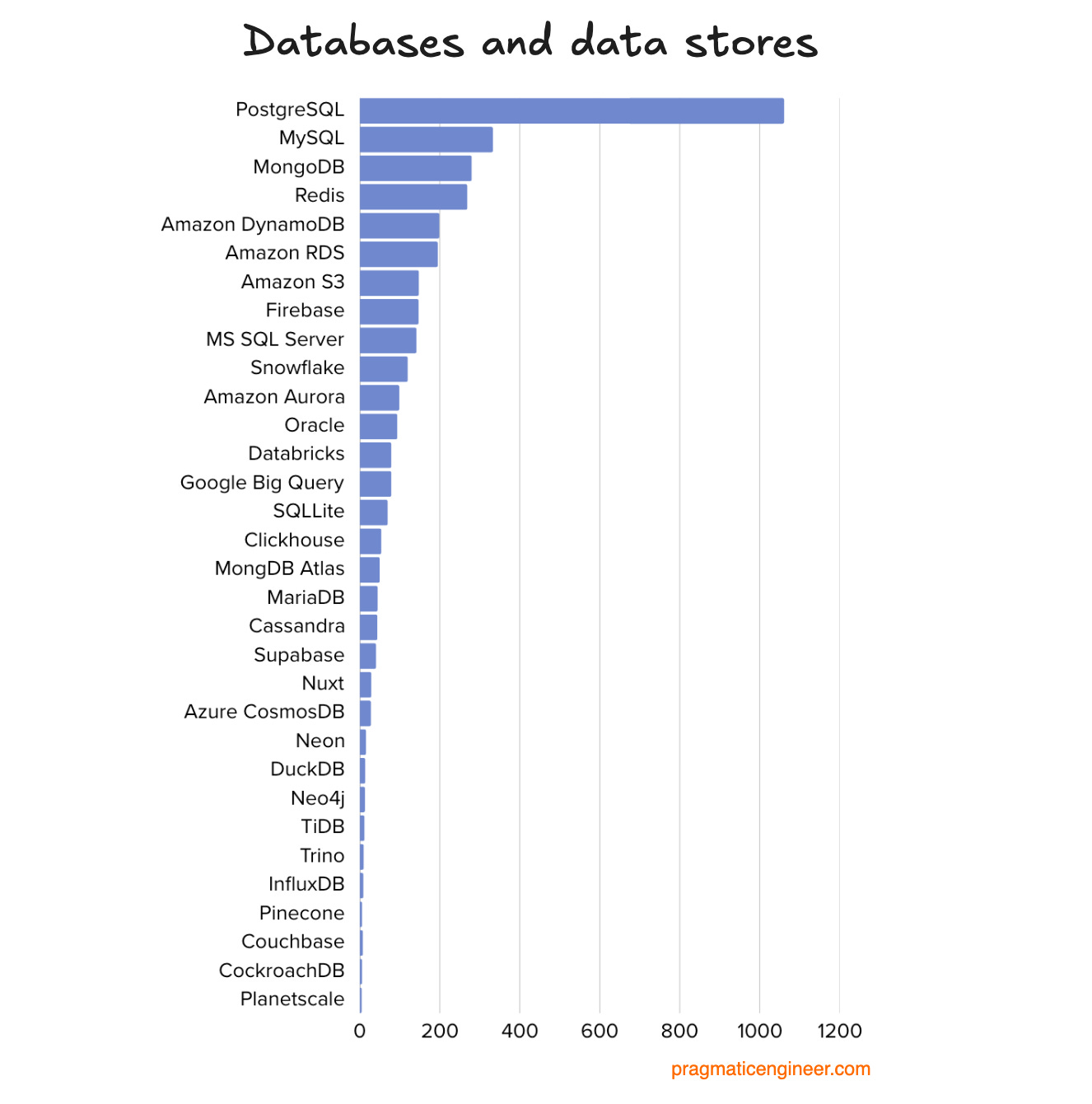
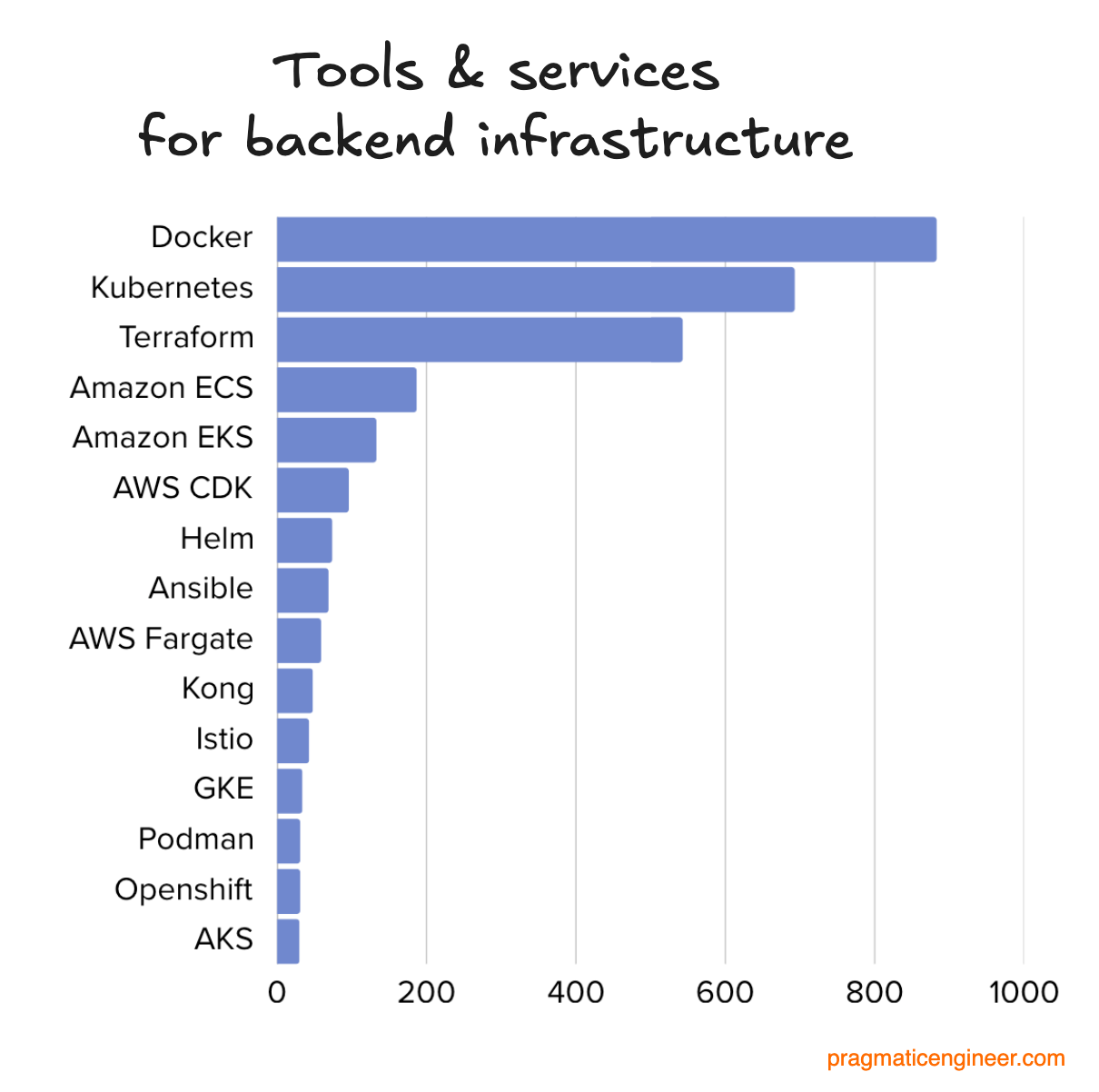
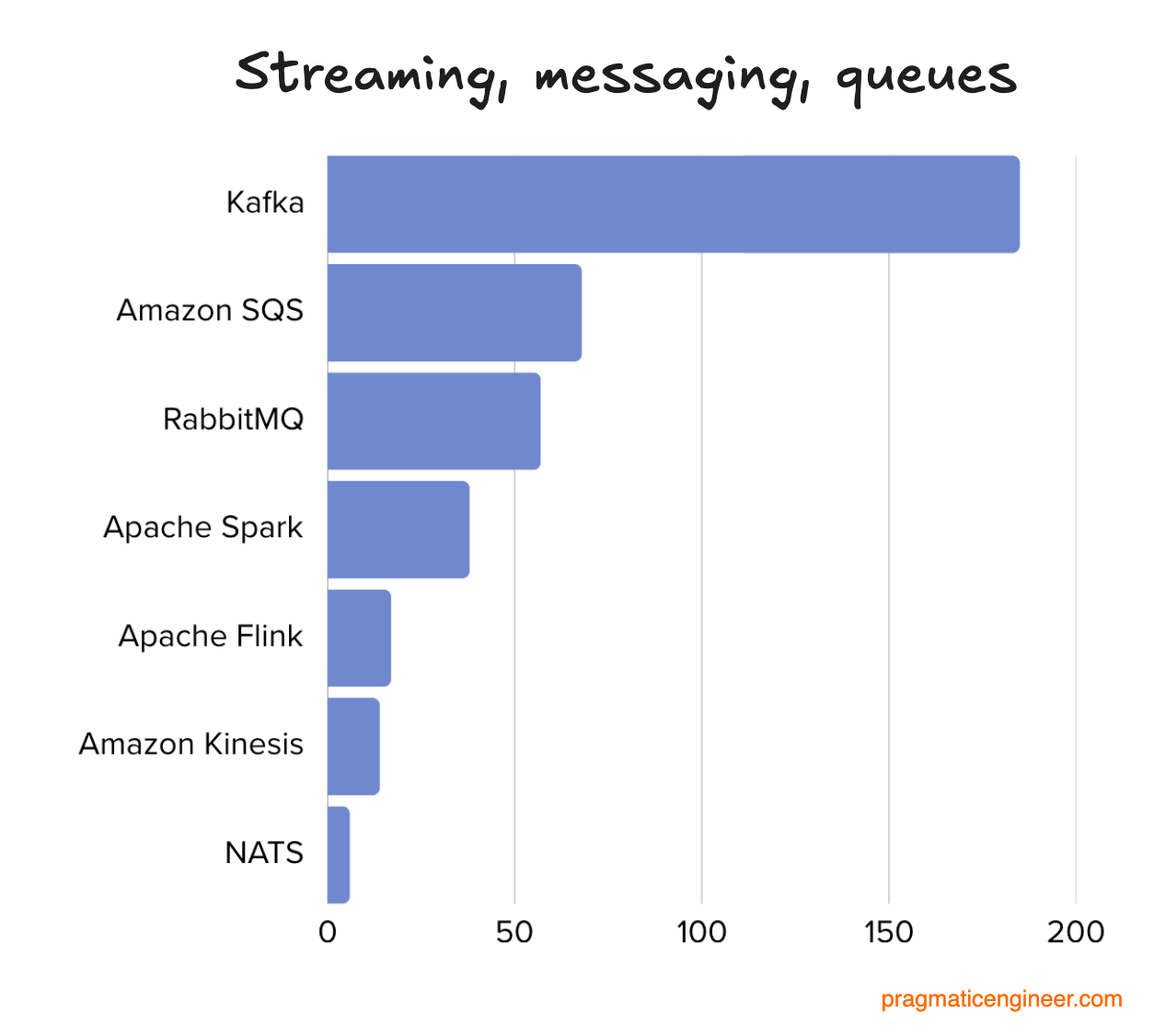
Thanks for the detailed write up as usual! Happy to have contributed 😊
The most surprising part to me was that you are surprised by the overlap or most used and most hated 😀
You know the old saying, there are 2 kinds of programming languages - ones everyone loves and ones everyone uses. Same for any software - you wont exactly remember disliking it while filling a survey if its not in your face every day, insisting on itself😅
I would expect you can overlap the most hated and most used in all categories to at least 80% accuracy 😁
Very good as always. The signal to noise ration on this newsletter is simply incredible! Well done.